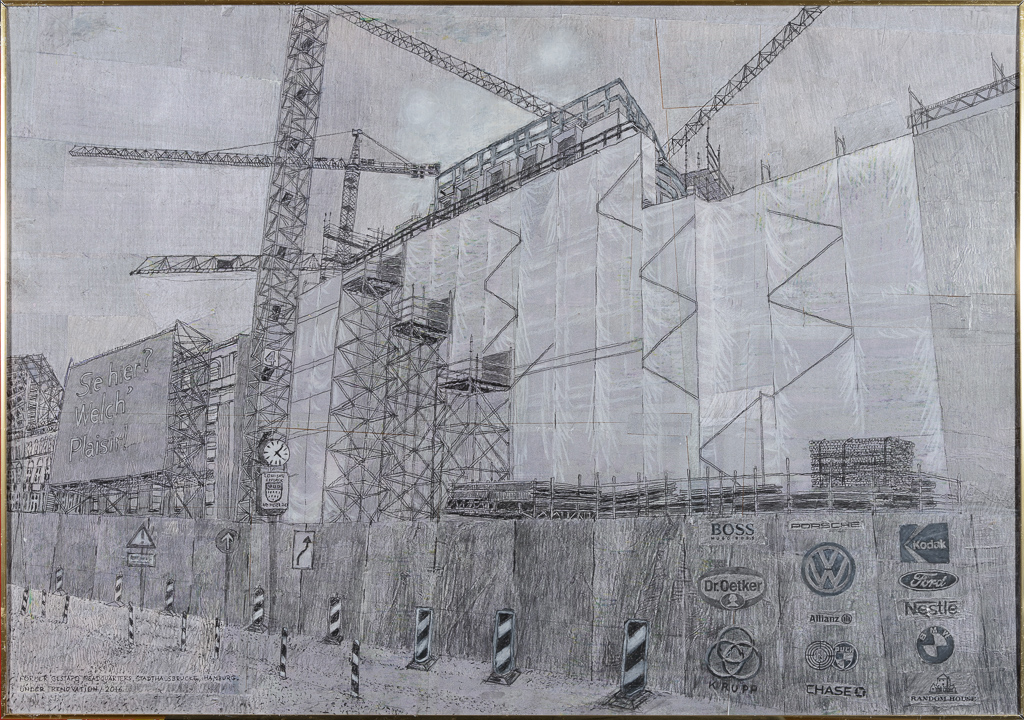.
Gensyn med Hamborg 1 • Hamburg revisited 1

Akryl. Kanvas, karton, avispapir.
Stadthöfe, Stadthausbrücke, Hamburg. Gestapos gamle hovedkvarter og forhørssted. Her blev mange fanger torteret, myrdet eller sendt videre til koncentrationslejre. Efter krigen anvendt som kontorbygning af Hamborg Kommune indtil 2009, hvor det blev solgt til et privat konsortium. Det er ombygget til butikscenter under kraftige protester fra familier til tidligere Gestapo-fanger og deres familier. I en boghandel i centeret er der i dag en lille udstilling om bygningens historie som hovedkvarter for Gestapo. Blyantstegningen er fra tiden, hvor bygningen blev ombygget til butikscenter.
I det følgende nævnes nogle af de kendte tyske firmaer, der samarbejdede med nazisterne. Nogle af firmanavnene fremgår af tegningen.
- Hugo Bosch var medlem af nazi-partiet og syede Hitlerjugend- og SS-uniformer. Han anvendte også polske og franske slavearbejdere.
- Ferdinand Porsche designede folkevognene på opfordring af Hitler. 4 ud af 5 arbejdere på folkevognsfabrikkerne var slavearbejdere. Porsche bad personlig Himmler om at måtte bruge særlige slavearbejdere fra Auschwitz (hvad de tyder på, at han vidste hvad der foregik i lejren).
- Rudolf-August Oetker, der ejede Dr. Oetker var medlem af nazipartiet og østrigsk SS-officer (SS blev dømt som en kriminel organisation under Nürnbergprocesserne). Han kom aldrig for retten og fortsatte med at lede firmaet. Han døde først i 2007.
- Bayer/IG Farben producerede Zyklon B gas til gaskamrene. De støttede økonomisk og hjalp lægen Joseph Mengele med uhyggelige eksperimenter på Auschwitz-fanger.
- Bogforlaget Random House og søsterfirmaet Bertelsmann udgav bøger med nazistisk propaganda bl.a. bogen Sterilization og Euthanasia. En støtte til kristen etik”.
- Nestle, Kodak (den tyske afdeling), BMW, Krupp, Puch-knallerter og Siemens havde alle kontakter til Nazi-partiet og brugte i stort tal koncentrationslejrfanger iproduktionen.
- Siemens producerede også krematorieovne til koncentrationslejrene.
Rigtig mange amerikanske firmaer leverede varer til den tyske hær indtil USA trådte ind i krigen og der blev indført eksportforbud. Bl.a. Standard Oil, IBM, Ford og Coca-Cola.
Acryl. Canvas, carton, newspaper.
Stadthöfe, Stadthausbrücke, Hamburg. The Gestapo’s old headquarters and interrogation site in which many prisoners were tortured, murdered or sent on to concentration camps. After the war, it was used as an office building by Hamburg City Council until 2009, and then sold to a private consortium. It was converted into a shopping center despite strong protests from the families of former Gestapo prisoners. A bookstore in the center is today home to a small exhibition about the building’s history as the Gestapo headquarter. The pencil drawing is from the time when the building was converted into a shopping center.
The following are some of the well-known German companies that collaborated with the Nazis. Some of the names appear in the drawing.
- Hugo Bossch was a member of the Nazi Party and produced the uniforms of the Hitler Jugend and SS . He also employed Polish and French slave laborers.
- Ferdinand Porsche designed the Volkswagen at the request of Hitler. 4 out of 5 workers at the Volkswagen factories were slave laborers. Porsche personally asked Himmler to use special slave laborers from Auschwitz (it is suggested that he knew what was going on in the camp).
- Rudolf-August Oetker, who owned Dr. Oetker, was a member of the Nazi Party and an Austrian SS officer (the SS was convicted as a criminal organization during the Nuremberg Trials). He never went to court and continued to run the company. He died in 2007.
- Bayer/IG Farben produced Zyklon B gas for the gas chambers. They financially supported and helped the doctor Joseph Mengele with his gruesome experiments on Auschwitz prisoners.
- The book publisher Random House and the sister company Bertelsmann published books with Nazi propaganda, including the book “Sterilization and Euthanasia. A support for Christian ethics”.
- Nestlée, Kodak (the German branch), BMW, Krupp, Puch mopeds and Siemens all had contacts with the Nazi Party and used a large number of concentration camp prisoners in their production lines. Siemens also produced crematorium ovens for the concentration camps.
Many American companies supplied goods to the German army until the United States entered the war and an export ban was imposed, including Standard Oil, IBM, Ford and Coca-Cola.
Acryl. Kanvas, Karton, Zeitung.